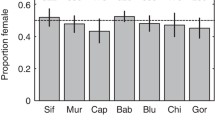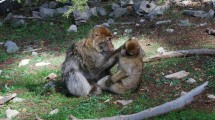Abstract
Demographic parameters in any primate group may reflect crucial aspects of its social structure and behaviour (Altmann and Altmann, 1979; Dunbar, 1979). They also form the basis for understanding the relationship between the group and its environment and are essential for successful management and conservation. The structure and dynamics of a population can be studied at several levels. A simple approach is to treat individuals as biologically identical to express numbers in the population as an average over several years and to investigate the causes for this value. The study of fluctuations in total numbers as related to changes in environment goes a step further and, at a more advanced level, may be aimed at expressing rate of change in numbers as a difference between birth rate and death rate. More desirable, though not often possible, is a study which discards the simplifying but unrealistic assumption that animals are identical.
Access this chapter
Tax calculation will be finalised at checkout
Purchases are for personal use only
Preview
Unable to display preview. Download preview PDF.
Similar content being viewed by others
References
Altmann, S.A. and Altmann, J., 1979. Demographic constraints on behaviour and social organization. In: I.R. Bernstein and E.O. Smith (eds.), “Primate Ecology and Human Origins”, pp. 47–63, Garland Publishing, New York.
Burton, F.D ., 1972. The integration of biology and behaviour in the socialization of Macaca sylvanaof Gibraltar. In: F.E, Poirier (ed.), “Primate Socialization”, pp.26. 62. Random House, New York.
Burton, F.D. and Sawchuk, L.A., 1974. Demography of Macaca sylvanusof Gibraltar. Primates, 15: 271–278.
Burton, F.D. and Sawchuk, L.A., 1982. Birth intervals in M. sylvanusof Gibraltar. Primates, 23: 140–144.
Chalmers, N.R., 1968. Group composition, ecology and daily activities of free-living mangabeys in Uganda. Folia Primatol., 8: 247–262.
Clifford, Q.J., Callanan, C. and Smith, S.E.G., 1972. The Barbary apes of Gibraltar. Blue Bk. Vet. Prof., 22: 167–169.
Dittus, W.P.J., 1975. Population dynamics of the Toque monkey, Macaca sinica. In: R.H. Tuttle (ed.), “Socioecology and Psychology of Primates”, pp. 125–151. Mouton, The Hague.
Drickamer, L.C., 1974. A ten-year summary of reproductive data for free ranging macaca mulatta. Folia primatol., 21: 61–80.
Dunbar, R.I.M., 1979. Population demography, social organisation and mating strategies. In: I.R. Bernstein and E.O. Smith, (eds.), “Primate Ecology and Human Origins”, pp. 65–88, Garland Publishing, New York.
Dunbar, R.I.M., 1980. Demographic and life history variables of a population of Gelada baboons (Theropithecus gelada). J. Anim. Ecol., 49: 485–506.
Erwin, J., 1979. Aggression in captive macaques: interaction of social and spatial factors. In: J. Erwin, T.L. Maple and G. Mitchell (eds.), “Captivity and Behaviour: Primates in Breeding Colonies, Laboratories and Zoos”, pp. 139–171, Van Nostrand Rheinhold Co., New York.
Fa, J.E., 1981. The apes on the rock. Oryx., 16: 73–76.
Frisch, R.E. and MacArthur, J.W., 1974. Menstrual cycles: fatness as a determinant of minimum weight for height necessary for their maintenance or onset. Science, 185: 949–951.
Hediger, H., 1964. “Wild Animals in Captivity”. Dover, New York.
Ikeda, H., 1982. Population changes and ranging behaviour of wild Japanese monkeys at Mt. Kawaradake in Kyushu, Japan. Primates, 23: 338–347.
Itani, J ., 1973, Twenty years with Mount Takasaki monkeys. In: G. Bermant and D.G. Lindburg (eds,) “Primate Utilization and Conservation”, pp. 101–126. Wiley, Interscience, New York.
Iwamoto, T., 1974. A bioeconomic study of a provisional troop of Japanese monkeys (Macaca fuscata) at Koshima Islet, Miyazaki. Primates, 15: 241–262.
Kenyon, E.R., 1938. “Gibraltar under Moor, Spaniard and Briton”, Methuen, London.
Koford, C.B., 1965. Population dynamics of rhesus monkeys on Cayo Santiago. In: I. DeVore (ed.), “Primate Behaviour”, Rinehart and Winston, New York.
Koford, C.B., 1966. Population changes in rhesus monkeys: Cayo Santiago (1960-1964). Tulane Studies in Zoology, 13: 1–7.
Koyama, N., Norikoshi, K. and Mano, T., 1975. Population dynamics of Japanese monkeys at Arashiyama. In: S. Kondo, M. Kawai and Ehara, A. (eds.), “Contemporary Proc. of the Fifth International Congress of Primatology, Nagoya” pp. 411–417. Karger, Basel,
Loy, J.D., 1970. Estrus behaviour of free-ranging Rhesus monkeys (Macaca mulatta): a study of continuity and variability. Diss. Abstr. Int., 30B: 3001.
MacRoberts, M.H., 1970. The social organization of Barbary apes (Macaca sylvana) on Gibraltar. Am. J. Phys. Anthr.33: 83–100.
MacRoberts, M.H. and MacRoberts, B.R., 1966. The annual reproductive cycle of the Barbary ape (Macaca sylvana) in Gibraltar. Amer. J. Phys. Anthv., n.s. 25: 299–304.
MacRoberts, M.H. and MacRoberts, B.R., 1971. The apes of Gibraltar. Natural History, N.Y. 80: 38–47.
Masui, K., Sugiyama, Y., Nishimura, A. and Ohsawa, T., 1975. The life table of Japanese monkeys at Takasakiyama. In: M. Kawai, S. Kondo and A. Ehara (eds.), “Contemporary Primatology”, pp. 401–406, Karger, Basel.
Nozawa, K., 1972. Population genetics of Japanese monkeys: 1. Estimation of the effective troop size. Primates, 13: 381–393.
Ohsawa, H., Sugiyama, Y. and Nishimura, A., 1977. Population dynamics of Japanese monkeys at Takasakiyama by the marking trace. In: Y. Sugiyama (ed), “Population Dynamics of Japanese Monkeys at Takasakiyama”, pp. 19–36, Oita City, Oita.
Russell, C., 1952. The apes of Gibraltar. Oryx., I: 22–24.
Sade, D.S., Cushing, K., Cushing, C., Dunaif, J., Figueroa, A., Kaplan, J.R., Lauer, C., Rhodes, D. and Schneider, J. 1976, Population dynamics in relation to social structure on Cayo Santiago. Yearbook of Physical Anthropology, 20: 253–262.
Siegel, S., 1956. “Non-parametric Statistics for the Behavioral Sciences”. MacGraw Hill, Tokyo.
Snedecor, G.W. and Cochran, W.G., 1967. Statistical methods. Iowa State Univ. Press, Ames, Iowa.
Sokal, R.R. and Rohlf, F.J., 1969. “Biometry”, Freeman, San Francisco.
Southwick, C.H., 1967. An experimental study of intra-group agonistic behaviour in Rhesus monkeys (Macaca mulatta). Animal Behaviour, 28: 182–209.
Southwick, C.H. and Siddiqi, M.F., 1976. Population dynamics of Rhesus monkeys in Northern India. In: H.S.H. Rainier and G.H. Bourne (eds.), “Primate Conservation”, pp. 339–362, Academic Press, New York.
Southwick, C.H., Siddiqi, M.F., Farooqui, M.Y. and Pal, B.C., 1976. Effects of artificial feeding on aggressive behaviour of Rhesus monkeys in India. Animal Behaviour, 24: 11–15.
Sugiyama, Y. and Oshawa, H., 1982. Population dynamics of Japanese monkeys with special reference to the effect of artificial feeding. Folia primatol., 39: 238–263.
Taub, D.M., 1980. Female choice and mating strategies among wild Barbary macaques (Macaca sylvanusL.). In: D.G. Lindburg (ed.), “The Macaques: Studies in Ecology, Behaviour and Evolution”, Van Nostrand Reinhold Company, New York.
Teleki, G., Hunt, E.E. and Pfifferling, J.H., 1976. Demographic observations (1963–1973) on the chimpanzee of Gombe National Park, Tanzania. J. Hum. Evol., 5: 559–598.
Tomaselli, R., 1972. Sulla nomenclatura della vegetazione Mediterranea sempreverde del punto di vista fisionomico-struttarale de ecologico. Atti Ist. bot. Univ. Lab. crittogam. Pavia6 (7): 3–8.
Tomaselli, R., 1977. Degradation of the Mediterranean maquis. In: Mediterranean Forests and Maquis: ecology, conservation and management. MAB Technical Notes 2: 33–72.
West, G.P., 1975. “Black’s Veterinary Dictionary”. Adams and Charles, London.
Witt, R., Schmidt, C. and Schmidt, J., 1981. Social rank and Darwinian fitness in a multimale group of Barbary macaques (Macaca sylvanaL. 1758): Dominance reversals and male reproductive success. Folia primatol, 6: 201–211.
Wolfe, L.D., 1979. Sexual maturation among members of a transported troop of Japanese macaques (Macaca fuscata). Primates, 20: 411–418.
Wolfe, L.D. and Sabra Noye, M.J., 1981. Reproductive senescence among female Japanese macaques (Macaca fuscata fuscata), J. Mamm., 62: 698–705.
Wrangham, R.W., 1974. Artificial feeding of chimpanzees and baboons in their natural habitat. Animal Behaviour, 22: 83–93.
Zeuner, F.E ., 1952. Monkeys in Europe past and present. OryxI: 265–273.
Author information
Authors and Affiliations
Editor information
Editors and Affiliations
Rights and permissions
Copyright information
© 1984 Plenum Publishing Corporation
About this chapter
Cite this chapter
Fa, J.E. (1984). Structure and Dynamics of the Barbary Macaque Population in Gibraltar. In: Fa, J.E. (eds) The Barbary Macaque. Springer, New York, NY. https://doi.org/10.1007/978-1-4613-2785-1_11
Download citation
DOI: https://doi.org/10.1007/978-1-4613-2785-1_11
Publisher Name: Springer, New York, NY
Print ISBN: 978-1-4612-9718-5
Online ISBN: 978-1-4613-2785-1
eBook Packages: Springer Book Archive




